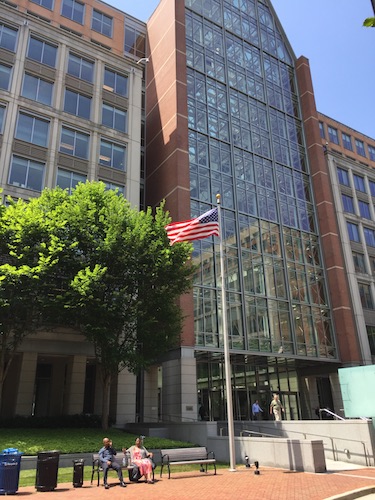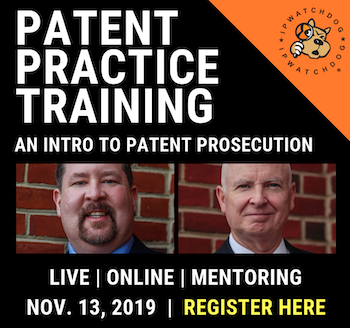 The United States Patent and Trademark Office has announced that the After Final Consideration Pilot 2.0 (AFCP 2.0) has been extended to September 30, 2020. AFCP 2.0 is part of our ongoing efforts towards compact prosecution.
The United States Patent and Trademark Office has announced that the After Final Consideration Pilot 2.0 (AFCP 2.0) has been extended to September 30, 2020. AFCP 2.0 is part of our ongoing efforts towards compact prosecution.
The decision to extend this popular and sensible program comes as no shock, and in fact has become a yearly ritual.
While the USPTO says the overall goal is facilitating compact prosecution, the specific goal of the AFCP 2.0 is to reduce pendency by reducing the number of RCEs (Requests for Continued Examination) and encouraging increased collaboration between the applicant and the examiner in order to effectively advance the prosecution of the application. Even more specifically, the goal is to address minor issues that remain in a case that can be addressed relatively quickly after final rejection, but which do require some additional time and consideration by the examiner.
AFCP 2.0 first began on May 19, 2013 and was originally scheduled to run only through September 30, 2013. It evolved from the After Final Consideration Pilot (AFCP), which started in 2012.
The purpose of the original After Final Consideration Pilot program was to attempt to move cases along without the need to file a Request for Continued Examination (RCE) when the case was very near to completion. Under AFCP the applicant could engage with the examiner beyond what is otherwise allowed under the rules if the examiner determined that the response filed could be fully considered within 3 hours for plant or utility application, or within 1 hour for design patent applications. See USPTO Memo to Examiners.
 Applicants who wish to participate in AFCP 2.0 must file a response under 37 CFR §1.116 together with a request for consideration under AFCP 2.0. The response after final rejection must include an amendment to at least one independent claim, and the amendment cannot broaden the scope of the independent claim in any aspect. The examiner will be allotted a set amount of time under AFCP 2.0 to consider the response, and to conduct a search if necessary. If the examiner’s consideration of a proper AFCP 2.0 request and response does not result in a determination that all pending claims are in condition for allowance, the examiner will request an interview with the applicant to discuss the response.
Applicants who wish to participate in AFCP 2.0 must file a response under 37 CFR §1.116 together with a request for consideration under AFCP 2.0. The response after final rejection must include an amendment to at least one independent claim, and the amendment cannot broaden the scope of the independent claim in any aspect. The examiner will be allotted a set amount of time under AFCP 2.0 to consider the response, and to conduct a search if necessary. If the examiner’s consideration of a proper AFCP 2.0 request and response does not result in a determination that all pending claims are in condition for allowance, the examiner will request an interview with the applicant to discuss the response.
There is no additional fee required to request consideration of an amendment after final rejection under AFCP 2.0, but any necessary existing fee, e.g., the fee for an extension of time, must still be paid.
The Office is encouraging applicants who believe a response to a final rejection under 37 CFR 1.116 will lead to allowance with only limited further searching and/or consideration by the examiner to consider requesting consideration of the response under the AFCP 2.0 pilot program.

![[IPWatchdog Logo]](https://ipwatchdog.com/wp-content/themes/IPWatchdog%20-%202023/assets/images/temp/logo-small@2x.png)

![[Advertisement]](https://ipwatchdog.com/wp-content/uploads/2024/04/Patent-Litigation-Masters-2024-sidebar-early-bird-ends-Apr-21-last-chance-700x500-1.jpg)

![[Advertisement]](https://ipwatchdog.com/wp-content/uploads/2021/12/WEBINAR-336-x-280-px.png)
![[Advertisement]](https://ipwatchdog.com/wp-content/uploads/2021/12/2021-Patent-Practice-on-Demand-recorded-Feb-2021-336-x-280.jpg)
![[Advertisement]](https://ipwatchdog.com/wp-content/uploads/2021/12/Ad-4-The-Invent-Patent-System™.png)







Join the Discussion
4 comments so far.
NotBob
November 8, 2019 01:45 pmIn the past I had some success with AFCP 2.0 requests, but it has become extremely infrequent of late.
If I’m facing a weak a final rejection and it’s clear that the examiner has not seriously considered my arguments, I have sometimes filed an AFCP 2.0 request along with a minor amendment to one independent claim. The hope is that the examiner will accept the amendment and take some time as provided by the AFCP 2.0 request to actually read the arguments and withdraw the rejection.
What actually seems to happen is that the examiner views the AFCP 2.0 request as a sign that I view the rejection as being strong and that an amendment is required (i.e. the exact opposite of how I actually see it). It appears to me that the examiners see the minor amendment with the AFCP 2.0 request and think “wow, this will be a super-easy RCE because it’s such a minor amendment.” But of course they need to assert the opposite (that the amendment will require additional searching, etc.) because they have an incentive to try to trigger an easy RCE and they need to make the statement in order justify refusal to enter the amendments.
In theory the 3 hours an examiner would get by accepting the AFCP 2.0 request should provide some incentive to acept the request, but it appears to be dwarfed by the incentives for an RCE. Someone correct me if I’m wrong, but my understanding is that 2 counts equal one Production Unit (PU). Unadjusted PUs range from 13.8 hours/PU to 31.6 hours/PU depending on the complexity of the technology. An examiner will get 1 count for a 1st Office Action after a first RCE, which is 7.9 hours for a GS-12. Even a GS-14 examiner (1.35 adjustment factor) in the most simple technology area (13.8 hours/PU) will get more hours for a first action after a first RCE than acceptance of an AFCP 2.0 request.
In the vast majority of cases an AFCP 2.0 request is a complete waste of time. It’s better to just argue a weak rejection on the merits after final and file an appeal. As far as I can tell, filing an AFCP 2.0 request actually increases the liklihood that an appeal will be required because examiners view it as signal that you will not file an appeal, and they apparently think they can get an easy RCE by rejecting the AFCP 2.0 request.
I did not fabricate this explanation from thin air. An examiner blurted out during an interview that he figured I must think I had a weak case or I wouldn’t have filed an AFCP 2.0 request and amendment. I told him exactly why I thought the rejection was weak even without the minor amendment, and that I’d recommend an appeal to the client. He apparently thought I was bluffing (he had obviously not taken the time to consider the arguments), so I filed an appeal. After I filed an appeal brief, he finally allowed the case.
Unfortunately, in many cases an appeal of a very weak rejection results in reopening prosecution after filing an appeal brief, followed by more weak rejections (apparently in part because the examiner is not getting counts for the subsequent office actions), followed by another appeal, etc.
It’s incredibly inefficient.
This is not true of all examiners, of course, just the ones who try to get to a final rejection as quickly as possible without conducting a decent search up front, without providing a reasonable basis for the rejections, etc.
Anon
September 24, 2019 12:05 pmI do not begrudge the presence of the program, but have found it far less satisfying in moving prosecution along.
There may be — on rare occasion — an examiner willing to use the option to do some “minor clean-up,” but the VAST majority of time I have the requirement to include at least one claim amendment MOST ALWAYS simply give the “out” that additional searching is needed, and that the request is thus denied (and this includes amendments well within the existing scope and plain reading of the specification as well as amending an independent claim with items from a dependent claim.
Meeting the requirement of “not broadening” has always been complied with, but this does NOT translate into an acceptance of the request. It appears that a default answer does not include the notion that a “new search” time is part of the package.
TFCFM
September 24, 2019 09:33 amI’ve found this program helpful on several occasions. What has to happen in order for the USPTO to make the policy a ‘permanent’ fixture?
Richard A. Schafer
September 23, 2019 10:30 pmWhy keep it as a “pilot” program, instead of just making it part of the standard procedural toolbox?